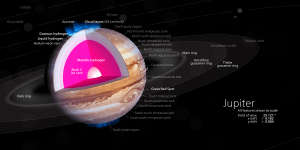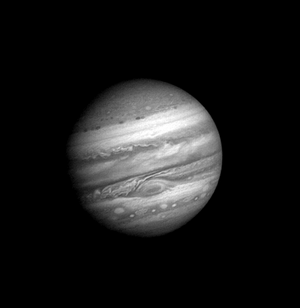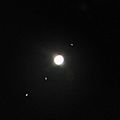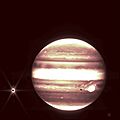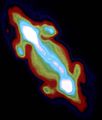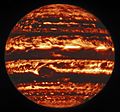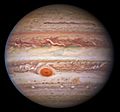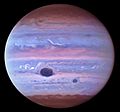Jupiter facts for kids

Full disk view of Jupiter in natural colour, with the shadow of its largest moon Ganymede cast onto it and the Great Red Spot at the left horizon.
|
|||||||||||||
| Designations | |||||||||||||
|---|---|---|---|---|---|---|---|---|---|---|---|---|---|
|
Named after
|
Jupiter | ||||||||||||
| Adjectives | Jovian | ||||||||||||
| Orbital characteristics | |||||||||||||
| Epoch J2000 | |||||||||||||
| Aphelion | 5.4570 AU (816.363 million km) | ||||||||||||
| Perihelion | 4.9506 AU (740.595 million km) | ||||||||||||
| 5.2038 AU (778.479 million km) | |||||||||||||
| Eccentricity | 0.0489 | ||||||||||||
|
|||||||||||||
| 398.88 d | |||||||||||||
|
Average orbital speed
|
13.07 km/s (8.12 mi/s) | ||||||||||||
| 20.020° | |||||||||||||
| Inclination |
|
||||||||||||
| 100.464° | |||||||||||||
| 21 January 2023 | |||||||||||||
| 273.867° | |||||||||||||
| Known satellites | 95 (as of 2023[update]) | ||||||||||||
| Physical characteristics | |||||||||||||
|
Mean radius
|
69,911 km (43,441 mi) 10.973 of Earth's |
||||||||||||
|
Equatorial radius
|
71,492 km (44,423 mi) 11.209 R⊕ (of Earth's) 0.10045 R☉ (of Sun's) |
||||||||||||
|
Polar radius
|
66,854 km (41,541 mi) 10.517 of Earth's |
||||||||||||
| Flattening | 0.06487 | ||||||||||||
| 6.1469×1010 km2 (2.3733×1010 sq mi) 120.4 of Earth's |
|||||||||||||
| Volume | 1.4313×1015 km3 (3.434×1014 cu mi) 1,321 of Earth's |
||||||||||||
| Mass | 1.8982×1027 kg (4.1848×1027 lb)
|
||||||||||||
|
Mean density
|
1.326 g/cm3 (0.0479 lb/cu in) | ||||||||||||
| 24.79 m/s2 (81.3 ft/s2) 2.528 g |
|||||||||||||
|
Moment of inertia factor
|
0.2756±0.0006 | ||||||||||||
| 59.5 km/s (37.0 mi/s) | |||||||||||||
| 9.9258 h (9 h 55 m 33 s) | |||||||||||||
|
Sidereal rotation period
|
9.9250 hours (9 h 55 m 30 s) | ||||||||||||
|
Equatorial rotation velocity
|
12.6 km/s (7.8 mi/s; 45,000 km/h) | ||||||||||||
| 3.13° (to orbit) | |||||||||||||
|
North pole right ascension
|
268.057°; 17h 52m 14s | ||||||||||||
|
North pole declination
|
64.495° | ||||||||||||
| Albedo | 0.503 (Bond) 0.538 (geometric) |
||||||||||||
| Temperature | 88 K (−185 °C) (blackbody temperature) | ||||||||||||
|
|||||||||||||
| −2.94 to −1.66 | |||||||||||||
| −9.4 | |||||||||||||
| 29.8" to 50.1" | |||||||||||||
| Atmosphere | |||||||||||||
|
Surface pressure
|
200–600 kPa (30–90 psi) (opaque cloud deck) |
||||||||||||
| 27 km (17 mi) | |||||||||||||
| Composition by volume | |||||||||||||
Jupiter is the largest planet in our Solar System. It is the fifth planet from the Sun. Jupiter is a gas giant, meaning it is very large and mostly made of gas. The other gas giants are Saturn, Uranus, and Neptune.
Jupiter's mass is huge, about 318 times the mass of Earth. This is more than twice the mass of all the other planets in our Solar System combined!
You can see Jupiter even without a telescope. The ancient Romans named this planet after their King of Gods, Jupiter. Jupiter is the third brightest object in the night sky. Only Earth's Moon and Venus are brighter.
Jupiter has 95 known moons and probably many more. About 50 of them are very small, less than five kilometres wide. The four largest moons of Jupiter are Io, Europa, Ganymede, and Callisto. They are called the Galilean moons because Galileo Galilei discovered them. Ganymede is the largest moon in the Solar System. It is even bigger than the planet Mercury.
Contents
What's in a Name?
Jupiter was named after the king of the gods in Roman mythology. The Greeks called him Zeus. The Romans called him Jupiter. The symbol for Jupiter, ![]() , comes from the Greek letter zeta. It has a horizontal line, which is a short way of writing Zeus.
, comes from the Greek letter zeta. It has a horizontal line, which is a short way of writing Zeus.
Jupiter's Structure and Size
Jupiter is the biggest planet in our Solar System. Its diameter is about 143,000 km. This is about eleven times wider than Earth.

Jupiter's Atmosphere
The atmosphere of Jupiter is mostly hydrogen (about 88-92%) and helium (8-12%). It also has small amounts of other gases.
Deep inside Jupiter, the lower atmosphere gets very hot, and the pressure is extremely high. This causes helium to turn into a liquid and "rain" down. Scientists believe Jupiter is made of similar gases to Saturn. However, it is different from Neptune or Uranus, which have much less hydrogen and helium.
Scientists cannot know for sure what materials are at Jupiter's very center. This is because the pressures and temperatures there are so extreme that we cannot create them on Earth.
Above the unknown inner core is a thick layer of liquid hydrogen. The pressure is so high that this hydrogen acts like a solid, but the heat makes it melt.
Jupiter is sometimes called a "failed star." This is because it is made of the same elements (hydrogen and helium) as the Sun. However, Jupiter is not large enough to have the extreme pressure and temperature needed for hydrogen to fuse into helium. This fusion is the energy source that powers the Sun and most other stars.
How Big is Jupiter?
Jupiter is more than twice as massive as all the other planets in the Solar System put together. It even gives off more heat than it gets from the sun. Jupiter is 11 times wider than Earth and 318 times as massive. The volume of Jupiter is 1,317 times the volume of Earth. This means 1,317 Earth-sized objects could fit inside it!
Cloud Layers and Storms
Jupiter has many bands of clouds that stretch horizontally across its surface. The light-colored parts are called zones, and the darker parts are called belts. These zones and belts often interact with each other, causing huge storms. Wind speeds of 360 kilometres per hour (km/h) are common on Jupiter. To compare, the strongest tropical storms on Earth are about 100 km/h.
Most of Jupiter's clouds are made of ammonia. There might also be clouds of water vapor, similar to clouds on Earth. Spacecraft like Voyager 1 have seen lightning on Jupiter's surface. Scientists think this lightning comes from water vapor because lightning needs water vapor to form. These lightning bolts can be up to 1,000 times more powerful than those on Earth. The brown and orange colors you see are caused by sunlight passing through or bending with the many gases in Jupiter's atmosphere.
The Great Red Spot
One of the most famous features in Jupiter's atmosphere is the Great Red Spot. It is a giant storm that is even bigger than the entire Earth! This storm has been observed since at least 1831, and possibly as early as 1665. Images from the Hubble Space Telescope have even shown two smaller "red spots" near the Great Red Spot. Storms on Jupiter can last for hours, or in the case of the Great Red Spot, for hundreds of years.
Jupiter's Magnetic Field
Jupiter has a magnetic field like Earth's, but it is 11 times stronger. It also has a huge and powerful magnetosphere. This magnetosphere traps radiation belts that are much stronger than Earth's Van Allen radiation belts. These radiation belts are so strong they could be dangerous to any spacecraft traveling near Jupiter. Scientists believe the magnetic field is caused by the large amounts of liquid metallic hydrogen in Jupiter's core.
The four largest moons of Jupiter and many smaller ones orbit within this magnetic field. This protects them from the solar wind. Jupiter's magnetic field is so large that it reaches the orbit of Saturn, which is 12 million km away. Earth's magnetosphere doesn't even cover its moon, which is less than 400,000 km away. Jupiter also has large aurorae, which are like the Northern and Southern Lights on Earth. These happen when charged particles from the volcanic moon Io hit Jupiter's atmosphere.
Jupiter's Ring System
Jupiter also has a thin planetary ring system. These rings are hard to see and were only discovered in 1979 by NASA's Voyager 1 probe. There are four parts to Jupiter's rings. The closest ring to Jupiter is called the Halo Ring. The next ring is the Main Ring. It is about 6,440 km wide and only 30 km thick. The Main and Halo rings are made of small, dark particles. The third and fourth rings, called the Gossamer Rings, are see-through and made from tiny dust particles. This dust probably comes from small meteors hitting the surface of Jupiter's moons. The third ring is named the Amalthea Gossamer Ring, after the moon Amalthea. The outer ring, the Thebe Gossamer Ring, is named after the moon Thebe. The outer edge of this ring is about 220,000 km from Jupiter.
Jupiter's Orbit and Rotation
The orbit of a planet is the path it takes to go around the Sun. It takes Jupiter 11.86 Earth years to orbit the Sun once. So, one year on Jupiter is equal to 11.86 years on Earth. The average distance between Jupiter and the Sun is 778 million kilometres. This is five times the distance between Earth and the Sun.
Jupiter is not tilted on its axis as much as Earth or Mars. This means it does not have seasons like summer or winter. Jupiter spins around very quickly. It completes one rotation in just 10 hours, making it the fastest spinning planet in the Solar System. Because it spins so fast, the planet bulges in the middle. This means the length of Jupiter's equator is much longer than the distance from pole to pole.
The Grand Tack Hypothesis
Jupiter's orbit is unusual compared to giant planets in other star systems, which are often much closer to their stars. This suggests something special happened in our Solar System. Scientists believe that Jupiter might have moved closer to the Sun and then back out again a long time ago. This journey would have greatly affected the Solar System. It could have changed the asteroid belt and made Mars smaller than it might have been. These ideas come from new models of the early Solar System.
Exploring Jupiter
Studying Jupiter from Earth
Jupiter is the third brightest object in the night sky, after the Moon and Venus. The first person known to truly study the planet was Galileo Galilei in 1610. He was the first to see Jupiter's moons: Io, Europa, Ganymede, and Callisto. He could do this because he used a telescope, unlike anyone before him.
No new moons were found for over two hundred years after Galileo. In 1892, astronomer E.E Barnard found a new moon using his observatory in California. He named it Amalthea. It was the last of Jupiter's moons to be discovered by humans looking through a telescope. In 1994, pieces of the comet Shoemaker Levy-9 hit Jupiter. This was the first time people saw a collision between two objects in the Solar System.
Spacecraft Missions to Jupiter
Seven spacecraft have flown past Jupiter since 1973. These include Pioneer 10 (1973), Pioneer 11 (1974), Voyagers 1 and 2 (1979), Ulysses (1992 and 2004), Cassini (2000), and New Horizons (2007).
The Pioneer missions were the first spacecraft to take close-up pictures of Jupiter and its moons. Five years later, the two Voyager spacecraft found over 20 new moons. They also took photos showing lightning on Jupiter's night side.
The Ulysses probe was sent to study the Sun. It only went to Jupiter after finishing its main job. Ulysses did not have cameras, so it took no photographs. In 2006, the Cassini spacecraft, on its way to Saturn, took some very clear pictures of Jupiter. Cassini also found a moon and took its picture, but it was too far away to show details.
The Galileo mission in 1995 was the first spacecraft to go into orbit around Jupiter. It flew around the planet for seven years and studied the four biggest moons. It also sent a probe into Jupiter's atmosphere to gather information. The probe went about 150 km deep before the extreme pressure of the gas crushed it. The Galileo spacecraft itself was also crushed in 2003 when NASA guided it into the planet. They did this to prevent the craft from crashing into Europa, a moon that scientists think might have life.
NASA sent another spacecraft to Jupiter called Juno. It launched on August 5, 2011, and arrived at Jupiter on July 4, 2016. NASA shared some results from the Juno mission in March 2018. Several other missions are planned to send spacecraft to Jupiter's moons Europa and Callisto. One called JIMO (Jupiter Icy Moons Orbiter) was canceled in 2006 because it cost too much money.
Jupiter's Moons
Jupiter has 95 known natural satellites. This number might grow in the future as instruments get better. Of these, 79 are smaller than 10 km across. The four largest moons are Ganymede, Callisto, Io, and Europa (listed from largest to smallest). They are known as the "Galilean moons" and can be seen from Earth with binoculars on a clear night.
The Galilean Moons
The moons discovered by Galileo—Io, Europa, Ganymede, and Callisto—are among the largest in the Solar System. The orbits of Io, Europa, and Ganymede follow a special pattern called a Laplace resonance. For every four times Io orbits Jupiter, Europa orbits exactly twice, and Ganymede orbits exactly once. This pattern causes the gravity of these three large moons to pull on each other, making their orbits slightly oval-shaped. This happens because each moon gets an extra tug from its neighbors at the same point in its orbit.
The oval shape of their orbits causes these three moons to flex and stretch as they get closer to and further from Jupiter. Jupiter's gravity pulls on them, stretching them out when they are close and letting them spring back when they move away. The friction from this constant flexing creates heat inside the moons. This is most clearly seen in the volcanic activity on Io, which experiences the strongest pulls. It also explains why Europa's surface looks geologically young, suggesting it has been resurfaced recently.
|
||||||||||||||||||||||||||||||||||||||||||||||||||||||||||
| The Galilean moons Io, Europa, Ganymede, and Callisto (in order of increasing distance from Jupiter) | ||||||||||||||||||||||||||||||||||||||||||||||||||||||||||
How Jupiter's Moons are Grouped
Jupiter's moons used to be put into four groups based on how they orbit. But since 1999, many small outer moons have been found, making the picture more complex. Now, Jupiter's moons are divided into several different groups, though some moons don't fit into any group.
The eight innermost regular moons orbit Jupiter in almost perfect circles, close to Jupiter's equator. Scientists think these moons formed at the same time as Jupiter. The rest are irregular moons, which are thought to be captured asteroids or pieces of captured asteroids that broke apart. The irregular moons within each group might have come from the same original body that broke up.
| Regular moons | |
|---|---|
| Inner group | This group of four small moons are all less than 200 km wide. They orbit Jupiter at a distance of less than 200,000 km and have very flat orbits. |
| Galilean moons | These four moons, discovered by Galileo Galilei, orbit between 400,000 and 2,000,000 km from Jupiter. They are some of the largest moons in the Solar System. |
| Irregular moons | |
| Himalia group | A group of moons that orbit in the same direction as Jupiter spins (prograde). They are tightly clustered and orbit about 11,000,000–12,000,000 km from Jupiter. |
| Carpo group | A small group of moons with highly tilted prograde orbits, about 16,000,000–17,000,000 km from Jupiter. |
| Ananke group | This group of moons orbits in the opposite direction to Jupiter's spin (retrograde). They are about 21,276,000 km from Jupiter with an average tilt of 149 degrees. |
| Carme group | A tightly clustered group of retrograde-orbiting moons that average 23,404,000 km from Jupiter with an average tilt of 165 degrees. |
| Pasiphae group | A spread-out group of retrograde moons that includes all the outermost moons. |
Jupiter's Role in the Solar System
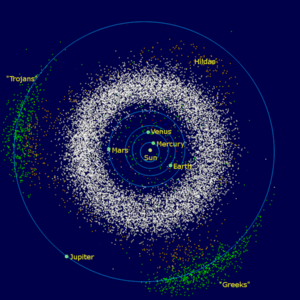
Jupiter's huge gravity has had a big impact on the Solar System. Jupiter helps protect the inner planets from comets by pulling them towards itself. Because of this, Jupiter gets hit by more comets than any other planet in the Solar System.
Two groups of asteroids, called Trojan asteroids, follow Jupiter in its orbit around the Sun. One group is called the Trojans and the other is called the Greeks. They travel around the Sun at the same speed as Jupiter.
Images for kids
-
Close up of the Great Red Spot imaged by the Juno spacecraft in April 2018
-
Orbit of Jupiter and other outer Solar System planets
-
Jupiter viewed in infrared by JWST (July 14, 2022)
-
Brown spots mark Comet Shoemaker–Levy 9's impact sites on Jupiter
See also
 In Spanish: Júpiter (planeta) para niños
In Spanish: Júpiter (planeta) para niños


